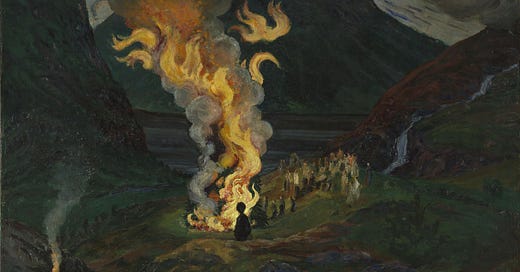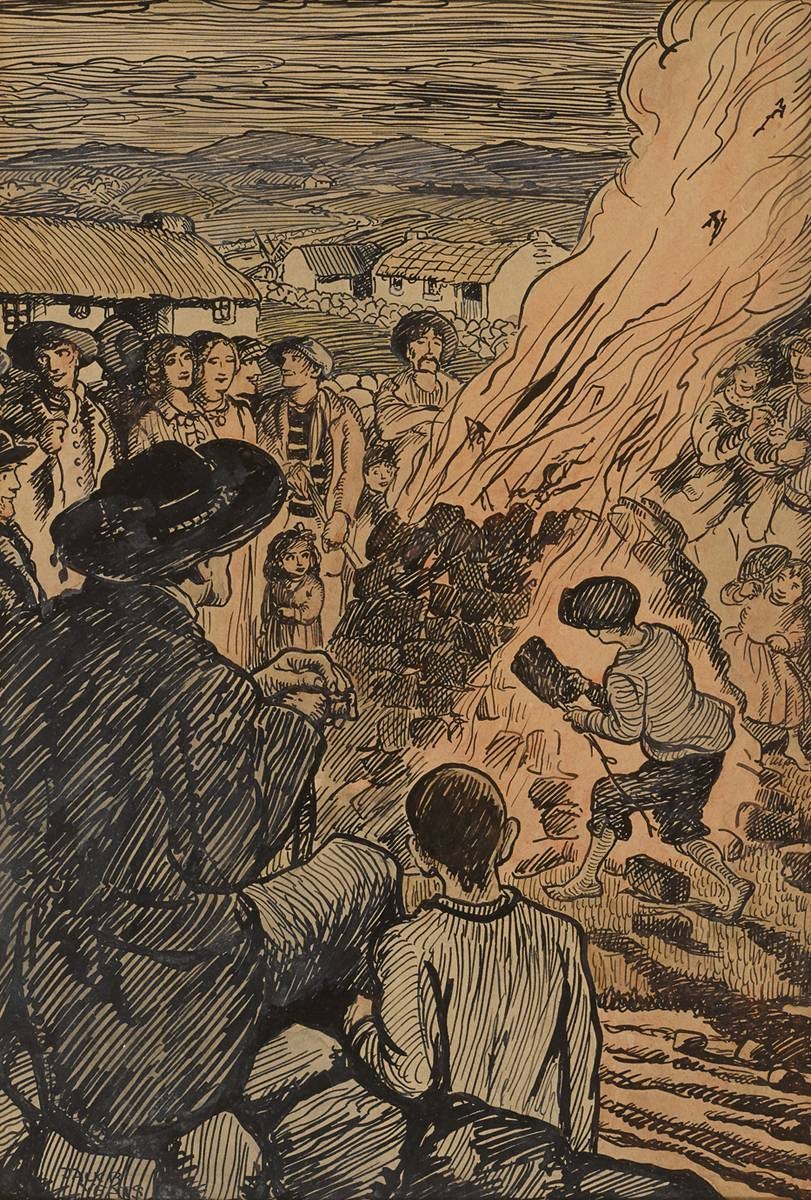I have been slow to update you all with a newsletter of late, as sometimes, life simply gets busy. But now we are well and truly into the summer and things feel as if they are slowing a bit.
I spent this morning on a long hike in the woods near where I live and was thinking about the fact that it is St. John’s Eve, also known in Norway as Jonsok or Sankthansaften. It was a holy day in Norway until 1770, although the more paganistic celebration of it that we associate with Finland and Sweden was more successfully battled by the Norwegian church than in those two countries.
Nevertheless, St. John’s Eve remains a night—even still—when in many parts of Norway large bonfires are lit, especially in coastal areas including Bergen, Ålesund and elsewhere. One of my favourite paintings is that by Nicolai Astrup from 1912 and 1926 of a St. John’s Eve bonfire:
Jack Yeats, brother of William, and in this year celebrated as one of our first ever Olympian medallists for Liffey Swim at the Paris Olympics in 1924, was also drawn to the subject of St. John’s Eve as in this pen, ink and watercolour:
In the ever rich resource of The Schools’ Collection of the National Folklore Archive, one description from Kilmore, Co. Leitrim suggests another way in which the Irish and the “Danes” (Vikings) might have shared history when it comes to St. John’s Eve:
On St John's eve a bone-fire [sic] is lit on every hill. Some say it is in honour of St John. Others say that a while before the battle of Clontarf the Danes were scattered and they fled to neighbouring houses for safety. Brian sent out a secret message to tell all the people to kill the Dane and to light a bone-fire on a high-hill as a warning to him when the Dane was killed This the people did and in memory of this it is said people light bone [sic] fires.
—The Schools’ Collection, Volume 0204, Page 315
My own interest in the traditions around this feast was piqued by one of the oldest Norwegian traditions around this time which, according to folklore, encourages you to place seven different types of wildflower under your pillow on that night. It is said that you will then dream of your future partner. This gave me the perfect start to a poem, St. John’s Eve, which was first published in an early issue of Waterford journal The Waxed Lemon:
First: gather, collect, then press
seven wildflowers to my breast
place them later beneath a pillow
for dreaming revealing flames
that dance & lick & ash ash rising
on a wind carried in a night
from Helleviga to Helvic Head
A note on the final line: Helleviga is in southern Norway, outside Kristiansand. You also find the place name as Hellevika. A “vik” is usually a cove, and the “helle” is thought normally to be from “heilig” or “holy”. “Vik” is also thought to by some—though this seems contested—from which we derive the term Viking. Helvic Head/Ceann Heilbhic in Co. Waterford, is a very clear Viking influenced placename.
However you are planning to mark the longest days, I hope you have a great summer!






Great post, David. I totally mis-read the bit about Jack Yeats and thought he'd won a medal for swimming at the age of 53! I thought, There's hope for me yet, but no, there probably isn't. Interesting to see Oliver Gogarty won a bronze medal at the same Olympiad for his "Ode to the Tailteann Games". I didn't know about the Olympic art competitions at all.